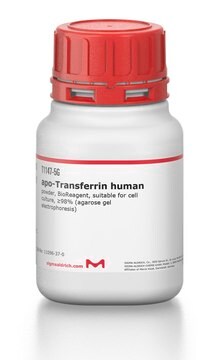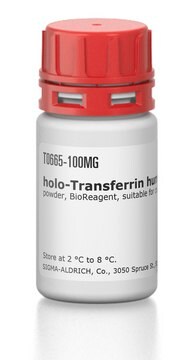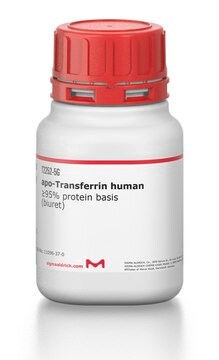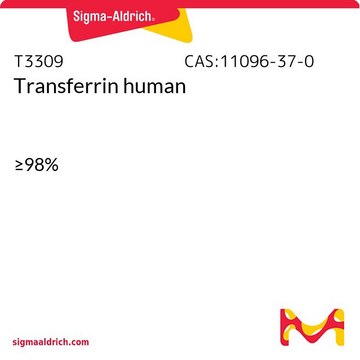T5391
apo-Transferrine human
γ-irradiated, powder, BioXtra, suitable for cell culture, ≥98%
Synonyme(s) :
Sidérophiline, Transferrine humaine
About This Item
Produits recommandés
Niveau de qualité
Stérilité
γ-irradiated
Gamme de produits
BioXtra
Pureté
≥98%
Forme
powder
Poids mol.
76-81 kDa
Concentration
~25 mM
Technique(s)
cell culture | mammalian: suitable
Impuretés
HIV and HBsAg, source material tested negative
iron, essentially free
Solubilité
H2O: 50 mg/mL
Numéro d'accès UniProt
Conditions d'expédition
wet ice
Température de stockage
−20°C
Informations sur le gène
human ... TF(7018)
Vous recherchez des produits similaires ? Visite Guide de comparaison des produits
Description générale
Application
- in Dulbecco′s modified Eagle medium/HamF12 (DMEM/F-12) to culture human adrenocortical carcinoma cells
- in DMEM/F-12 to culture neural precursor cells from mice
- in collecting medium NCSU23 to culture preantral follicles from porcine ovaries
Actions biochimiques/physiologiques
Autres remarques
Clause de non-responsabilité
Code de la classe de stockage
11 - Combustible Solids
Classe de danger pour l'eau (WGK)
WGK 3
Certificats d'analyse (COA)
Recherchez un Certificats d'analyse (COA) en saisissant le numéro de lot du produit. Les numéros de lot figurent sur l'étiquette du produit après les mots "Lot" ou "Batch".
Déjà en possession de ce produit ?
Retrouvez la documentation relative aux produits que vous avez récemment achetés dans la Bibliothèque de documents.
Les clients ont également consulté
Articles
How transferrin and other cell culture components affect the performance of serum-free, protein-free cell culture systems used for biomanufacturing heterologous proteins including monoclonal antibodies. The page introduces the in vitro chemistry and biochemistry of transferrin.
Notre équipe de scientifiques dispose d'une expérience dans tous les secteurs de la recherche, notamment en sciences de la vie, science des matériaux, synthèse chimique, chromatographie, analyse et dans de nombreux autres domaines..
Contacter notre Service technique









